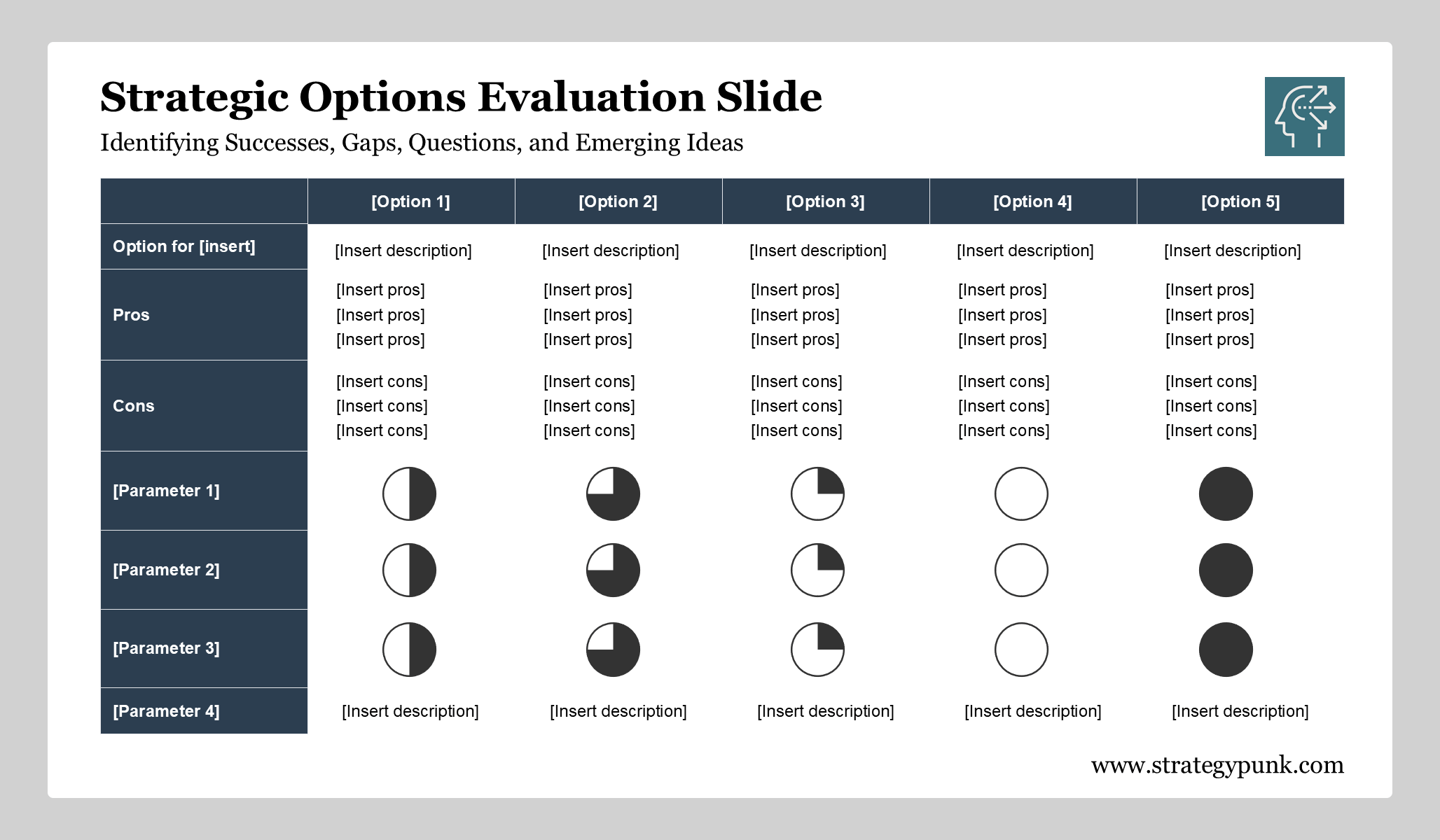Navigating the Market: Puma Through the Lens of PESTEL (Free PPT Analysis)
Unlock market strategies with our free PowerPoint template on Puma's PESTEL analysis. Dive into trends, opportunities, and challenges. Download now for insightful market navigation!

Dive into the dynamic world of Puma with our in-depth PESTEL analysis, now available in an easily accessible blog post that illuminates the brand's market navigation strategies.
We're offering a free PDF and PowerPoint template to enhance your understanding. These templates provide a profound, structured, visual way to explore Puma's external environment and strategic positioning.
Introduction
In the fast-paced and ever-evolving world of sportswear and fashion, only some brands have managed to maintain their relevance and appeal quite like Puma. Founded in 1948 by Rudolf Dassler in the small German town of Herzogenaurach, Puma has grown into a global powerhouse, with a presence in over 120 countries and annual sales exceeding €5 billion.
But what factors have successfully enabled Puma to navigate the complex and competitive landscape of the sportswear industry?
In this blog post, we'll use the PESTEL framework to examine the political, economic, social, technological, and legal factors that shape Puma's business environment and performance.
By the end, you'll have a comprehensive understanding of the opportunities and challenges facing deep insights into how this iconic brand positions itself for continued success in the years ahead.
So, lace up your sneakers, and let's begin this PESTEL journey!
Puma PESTLE Step-by-Step Analysis
The Puma PESTLE Analysis comprehensively examines the macro-environmental factors impacting Puma's business operations and strategic direction.
This analysis provides valuable insights into Puma's external challenges and opportunities by the following: Puma'scomprehensively examines and,
Puma Political Factors
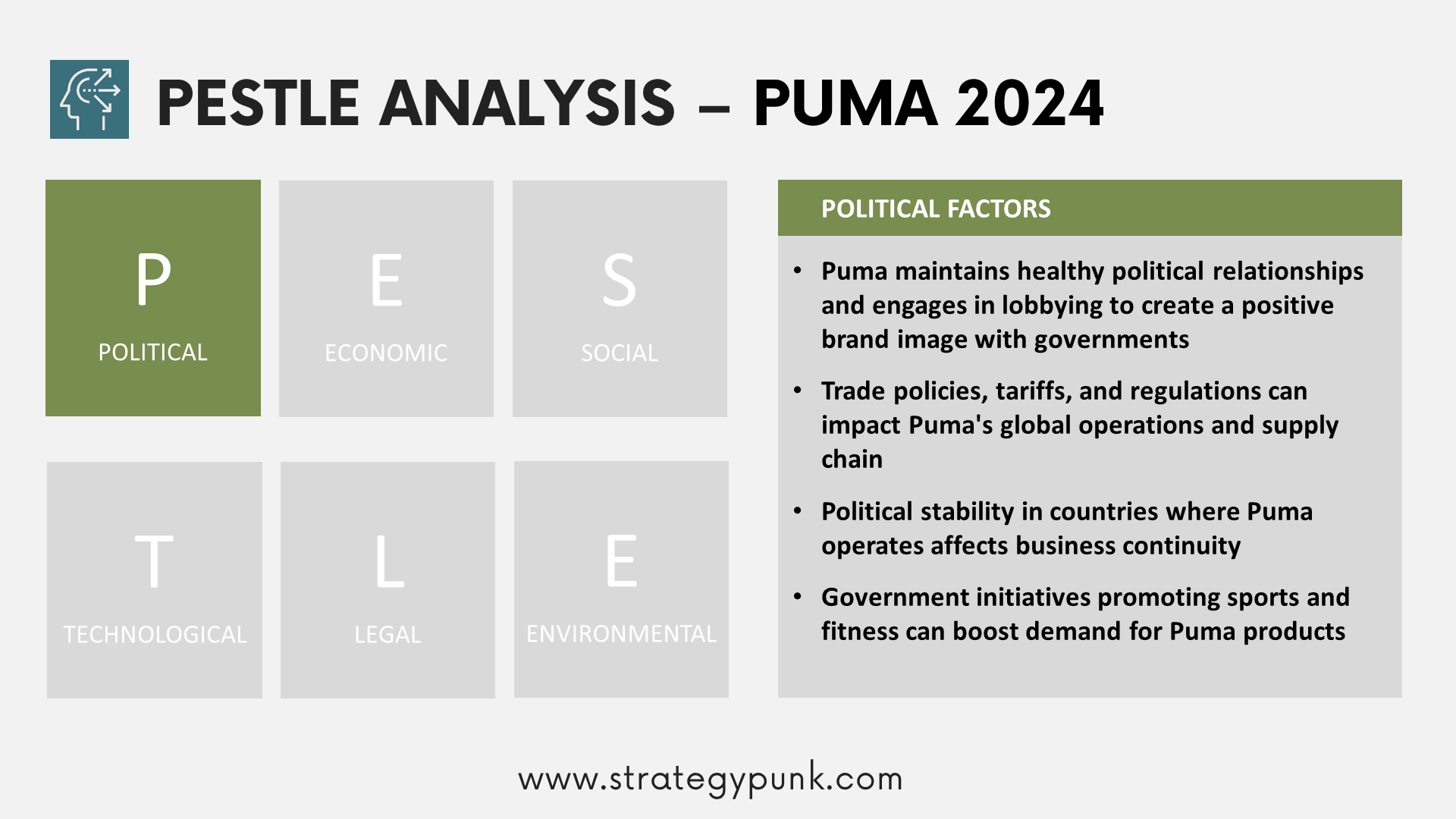
The political environment can significantly impact Puma's operations, especially given the company's global footprint. Some vital political factors to consider include:
Trade policies and tariffs: As an international brand, Puma is exposed to changes in trade regulations, tariffs, and customs duties that can affect its costs and supply chain. For example, trade tensions between the U.S. and China have led to increased tariffs on footwear imports.
Political stability: Political instability in the countries where Puma operates, manufactures, or sources materials can impact its performance. Geopolitical events like the Russia-Ukraine conflict have disrupted Puma's business in those markets.
Government initiatives: Policies promoting sports and fitness can benefit Puma by boosting product demand. Conversely, regulations around labor, environment, or specific materials could increase Puma's compliance costs.
Intellectual property protection: Puma uses trademarks, patents, and designs to differentiate its products. The strength of IP rights enforcement varies across countries and can affect Puma's ability to combat counterfeiting.
Summary
- Puma maintains healthy political relationships and engages in lobbying to create a positive brand image with governments
- Trade policies, tariffs, and regulations can impact Puma's global operations and supply chain
- Political stability in countries where Puma operates affects business continuity
- Government initiatives promoting sports and fitness can boost demand for Puma products
Puma Economic Factors
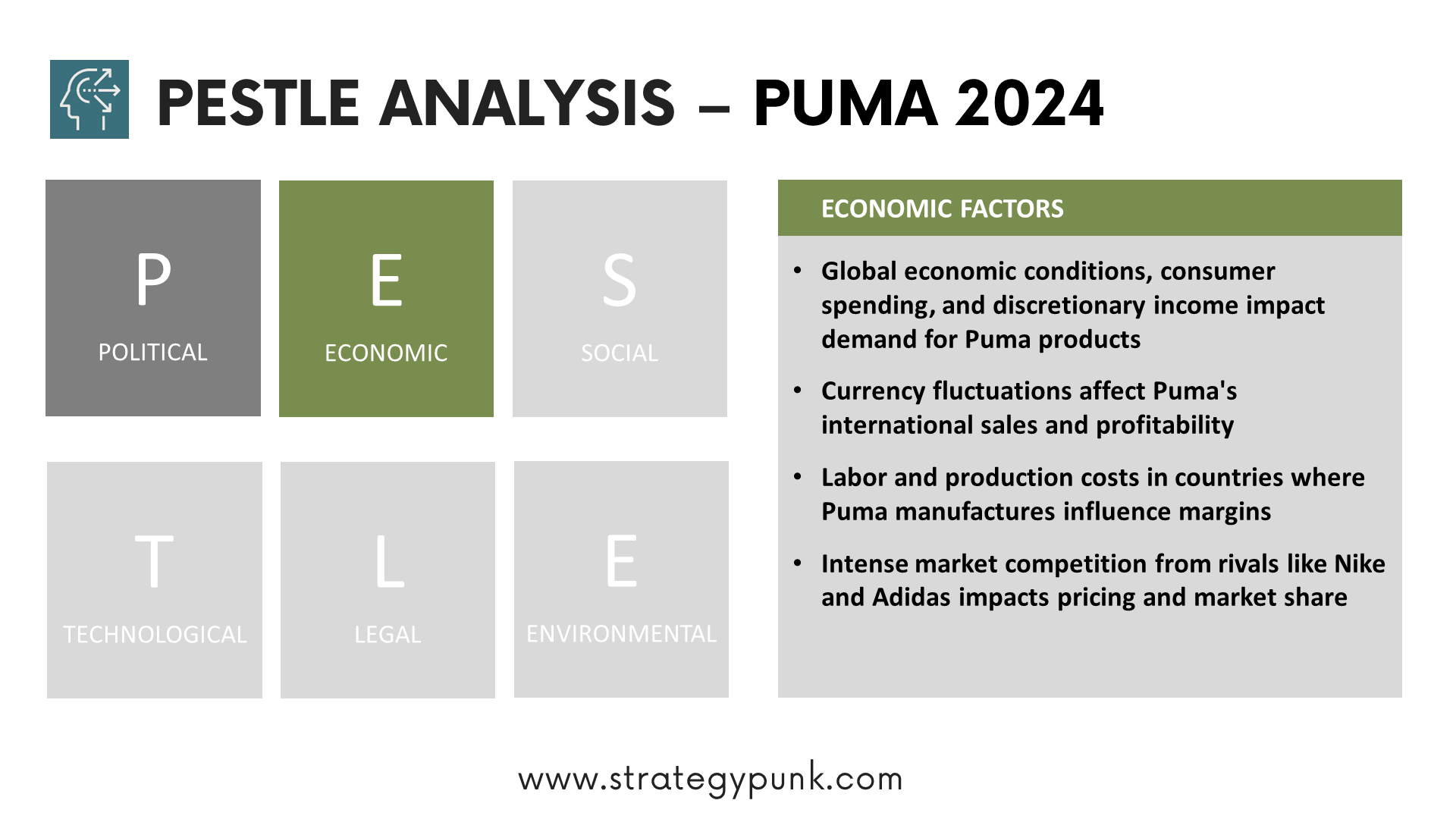
As a consumer discretionary company, Puma's performance is closely tied to the health of the global economy and factors like:
Consumer spending: Economic growth, employment, wages, and consumer confidence influence how much people are willing to spend on Puma's products. An economic slowdown could dampen demand.
Currency fluctuations: With over 60% of its sales coming from outside the Euro area, Puma is exposed to volatility in foreign exchange rates, which can impact its reported revenues and profitability.
Production costs: The costs of raw materials, labor, and energy can pressure Puma's margins. The company outsources most of its production to Asia for lower costs.
Market competition: Puma faces intense competition from other global sportswear giants like Nike, Adidas, and Drive, as well as its beginning smaller players. Competitive pressures influence Puma's pricing power and market share.
Summary:
- Global economic conditions, consumer spending, and discretionary income impact demand for Puma products
- Currency fluctuations affect Puma's international sales and profitability
- Labor and production costs in countries where Puma manufactures influence margins
- Intense market competition from rivals like Nike and Adidas impacts pricing and market share
Puma Social Factors
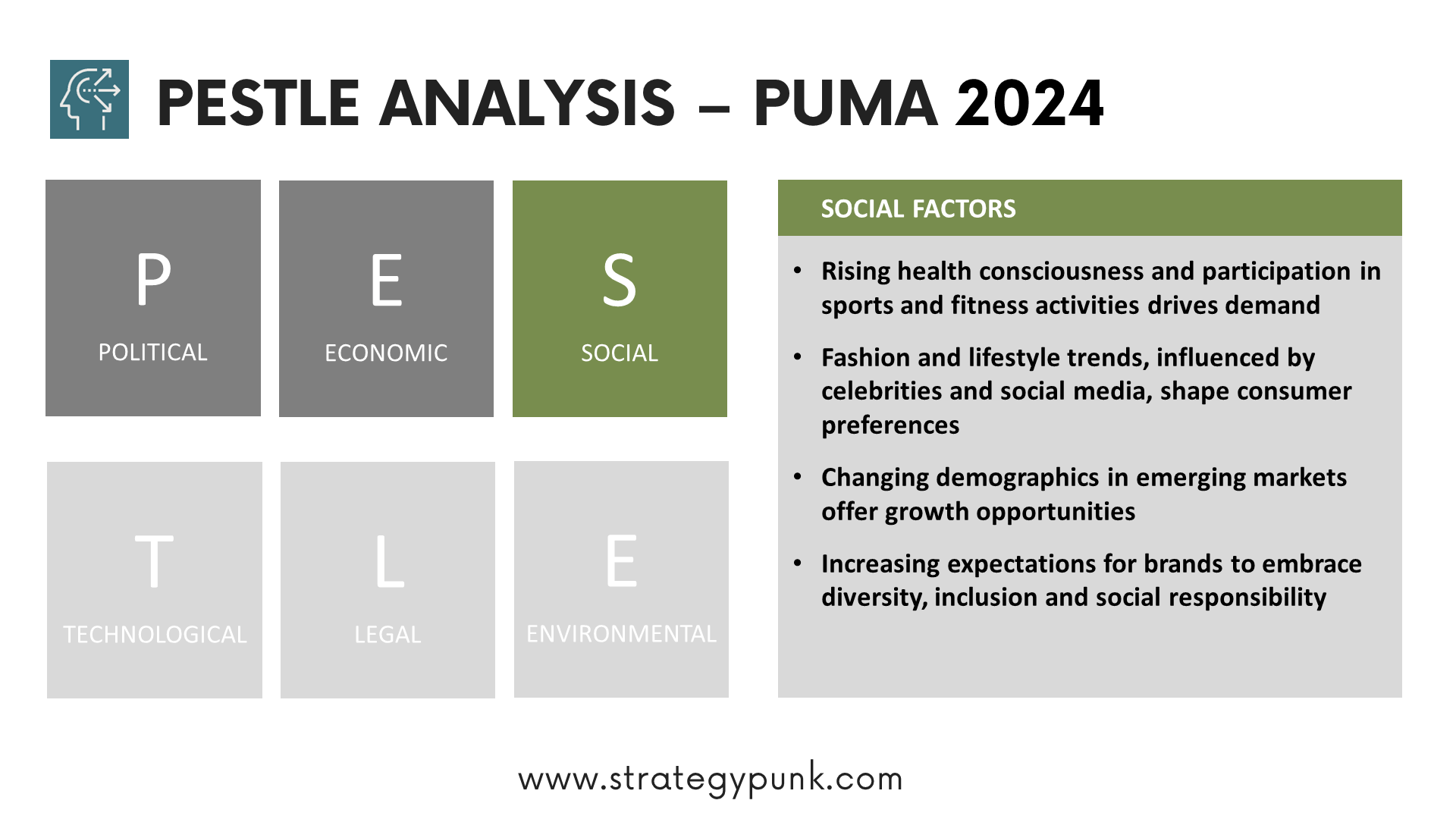
Puma's success depends on its ability to stay attuned to social and cultural trends, such as:
Health and fitness: Rising health consciousness and participation in sports and outdoor activities drive demand for Puma's performance-oriented products. The pandemic has further accelerated the athleisure trend.
Fashion and lifestyle: Puma has built a strong positioning by collaborating with celebrities, designers, and other brands to tap into streetwear and fashion trends. Influencers and social media play a crucial role in shaping consumer preferences.
Demographics: Population growth, urbanization, and a rising middle class in emerging markets like China and India offer growth opportunities for Puma. Meanwhile, the company must adapt its products and marketing to appeal to different generations, from Baby Boomers to Gen Z.
Diversity and inclusion: There is a growing social expectation for brands to embrace diversity and take a stand on social issues. Puma has tried to champion equality and inclusivity through its campaigns, ambassadors, and internal practices.
Summary:
- Rising health consciousness and participation in sports and fitness activities drive demand
- Fashion and lifestyle trends, influenced by celebrities and social media, shape consumer preferences
- Changing demographics in emerging markets offer growth opportunities
- Increasing expectations for brands to embrace diversity, inclusion, and social responsibility
Puma Technological Factors
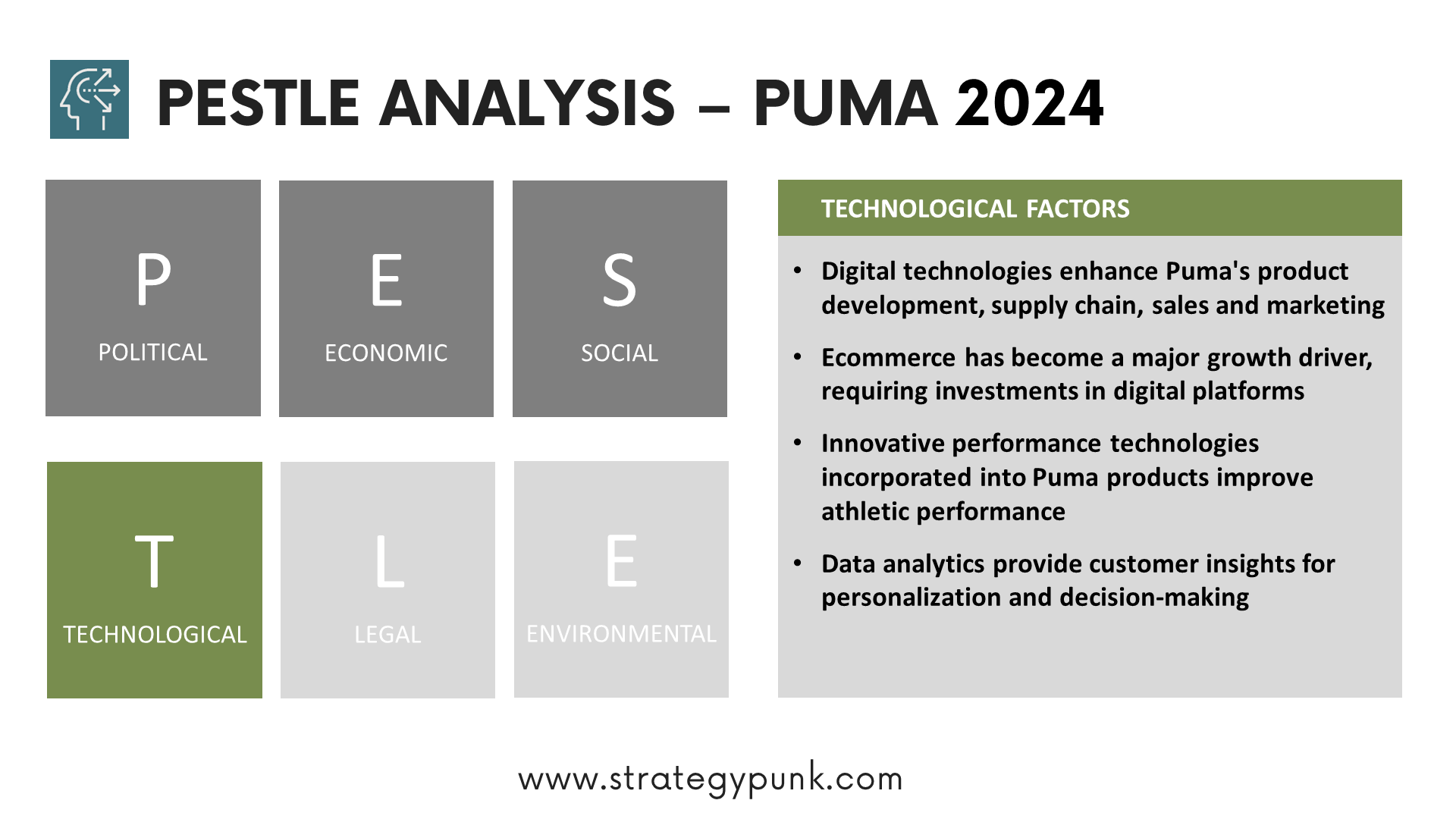
Technology transforms every aspect of Puma's business, from designing and manufacturing products to engaging with customers. Significant tech trends include:
Digital innovation: Puma invests heavily in digital capabilities to enhance its product development, supply chain, sales, and marketing. For example, it uses 3D design and virtual sampling to speed up the creation of new products.
E-commerce: Online sales have become a significant growth driver for Puma, especially during the pandemic. The company is upgrading its digital platforms and partnering with e-commerce players to improve its online presence and service.
Performance technology: Puma incorporates cutting-edge materials and technologies into its products to improve athletic performance. Its running shoes feature proprietary cushioning techs like NITRO and XETIC, while it has also ventured into smartwatches and other wearables.
Data and analytics: Puma harnesses data to gain deeper customer insights, personalize experiences, and make smarter business decisions. Tools like the PUMATRAC training app also help it build direct consumer relationships.
Summary:
- Digital technologies enhance Puma's product development, supply chain, sales and marketing
- E-commerce has become a significant, drive growth driver, requiring investments in digital platforms
- Innovative performance technologies incorporated into Puma products improve athletic performance
- Data analytics provide customer insights for personalization and decision-making
Puma Legal Factors
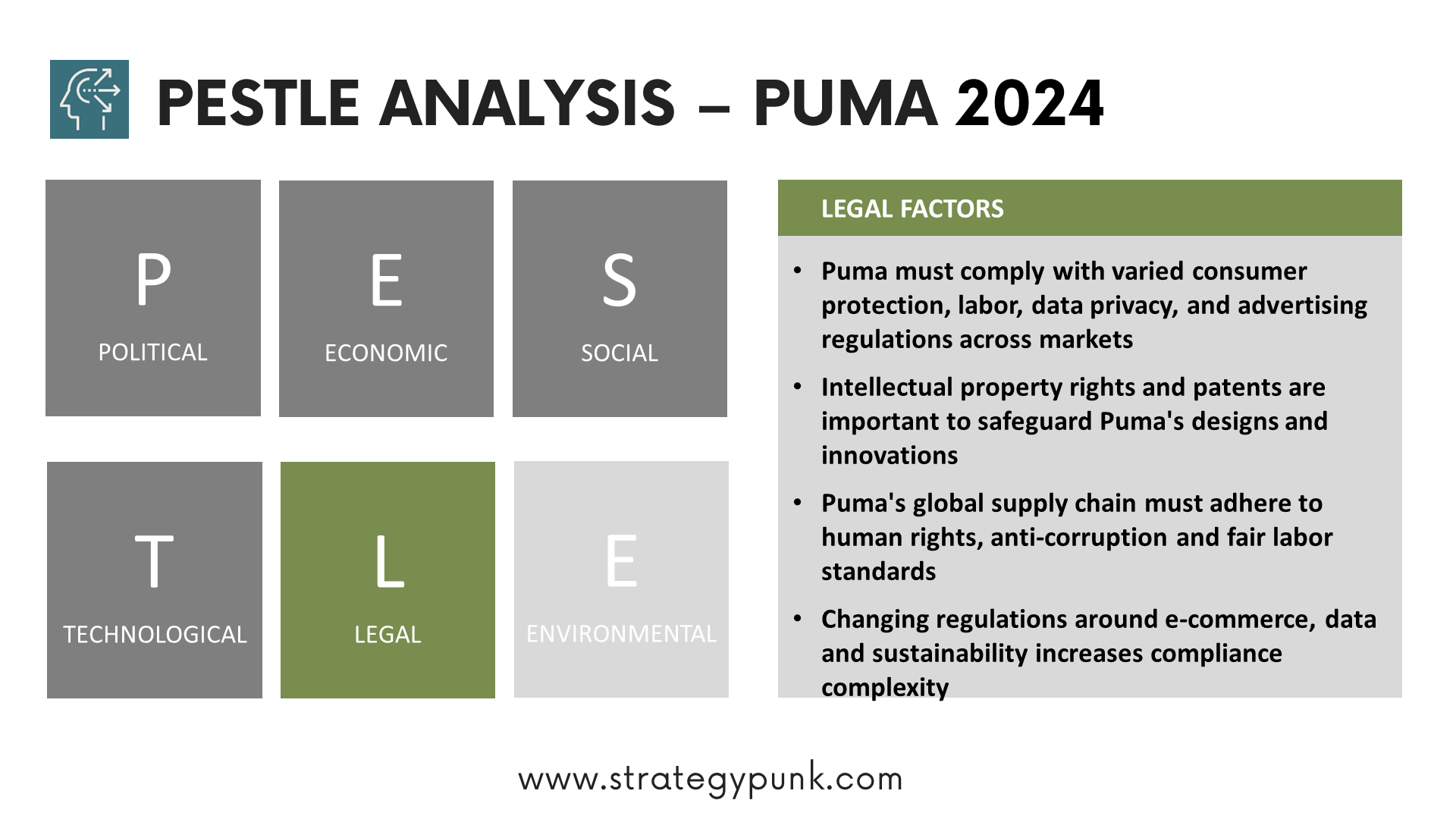
As a multinational corporation, Puma must navigate a complex web of legal and regulatory requirements related to:
Consumer protection: To avoid liability, Puma must ensure its products meet quality and safety standards, and that its marketing claims are truthful and substantiated.
Labor and human rights: Puma is responsible for upholding fair labor practices and human rights standards across its supply chain, or it risks legal action and reputational damage. The company has a supplier code of conduct and monitoring program in place.
Data privacy: With the growth of e-commerce and digital marketing, Puma must comply with evolving data protection regulations like GDPR. This includes safeguarding customer information and providing transparency around data collection and use.
Anti-corruption: As Puma expands into new markets, it must have robust policies and controls to prevent bribery, fraud, and other forms of corruption that could lead to legal penalties.
Summary
- Puma must comply with varied consumer protection, labor, data privacy, and advertising regulations across markets
- Intellectual property rights and patents are essential to safeguard Puma's designs and innovations
- Puma's global supply chain must adhere to human rights, anti-corruption and fair labor standards
- Changing regulations around e-commerce, data, and sustainability increases compliance complexity
Puma Environmental Factors
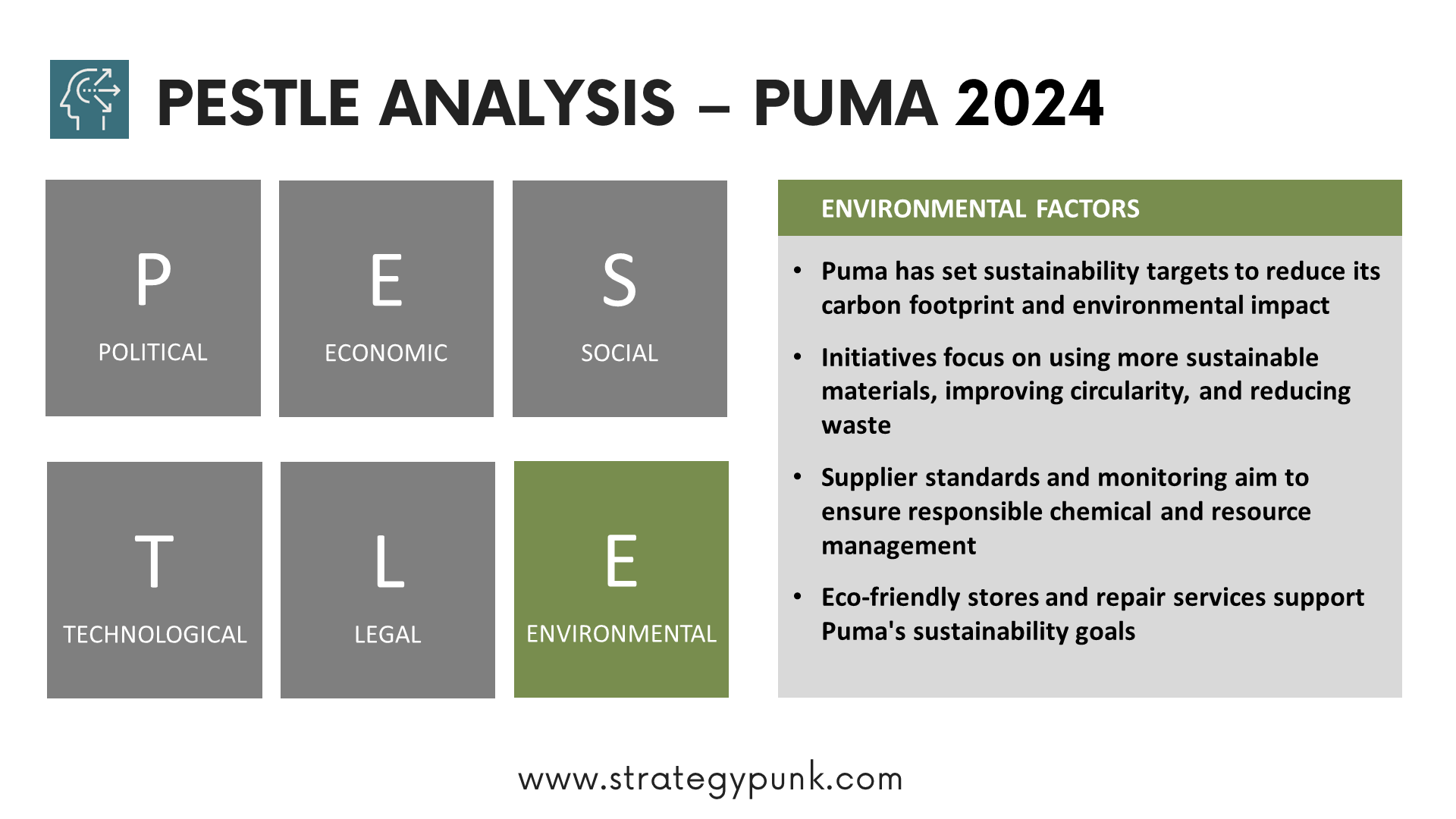
Sustainability has become imperative for Puma as consumers, investors, and regulators pay more attention to the fashion industry's environmental impact. Puma's sustainability strategy focuses on the following:
Climate action: Puma has set science-based targets to reduce carbon emissions and transition to renewable energy. It is working to make its supply chain more energy efficient and expand the use of recycled materials.
Circularity: Puma aims to move towards a circular business model where materials are recycled and reused. Initiatives include introducing products like the Cradle-to-Cradle certified InCycle collection and exploring resale and recycling options.
Puma increasingly uses more sustainable raw materials, such as Better Cotton, bluesign-certified polyester, and FSC-certified cardboard. It has also implemented stricter supplier standards regarding chemical and water management.
Eco-friendly stores: Puma is incorporating green building principles into its new stores and refurbishing existing ones to make them more energy—and resource-efficient. It is also testing new store concepts centered around circularity and repair.
Summary
- Puma has set sustainability targets to reduce its carbon footprint and environmental impact
- Initiatives focus on using more sustainable materials, improving circularity, and reducing waste
- Supplier standards and monitoring aim to ensure responsible chemical and resource management
- Eco-friendly stores and repair services support Puma's sustainability goals
Conclusion
By examining Puma through the lens of the PESTLE framework, it becomes clear that the company's success depends on its ability to understand and adapt to the complex forces shaping its operating environment.
From navigating geopolitical tensions and economic headwinds to staying on the pulse of social trends and technological shifts, Puma must continually evolve its strategies and capabilities to stay ahead of the game. At the same time, the company faces growing pressure to minimize its environmental footprint and uphold high ethical standards across its value chain.
Puma's prospects will be determined by its ability to innovate, inspire, and positively impact. By leveraging its strong brand heritage, sports credibility, and lifestyle appeal while embracing sustainability and digital transformation, Puma is well-positioned to continue its winning streak.
Of course, the road ahead has risks and challenges. Intensifying competition, changing consumer habits, and supply chain disruptions are some potential hurdles Puma will need to overcome. But with its track record of agility and resilience, there's no doubt that this big cat of the sportswear jungle will keep pouncing.
PUMA PESTLE Analysis PowerPoint Template
free and fully editable PPT template
Dive deep into the strategic business environment of Puma with our comprehensive PESTLE analysis PDF and PowerPoint template, available for free download.
Uncover insights into the Political, Economic, Social, Technological, Legal, and Environmental factors influencing Puma and leverage this knowledge to inform decision-making and strategy development.

Puma PESTLE Analysis PowerPoint Template
Puma PESTLE Analysis PDF Template
Discover more
Clickworthy Resources
The Basics of a PEST / PESTLE Analysis: A Complete Guide (Plus FREE Template)
The Basics of a PEST / PESTLE Analysis: A Complete Guide (Plus FREE PowerPoint and Google SlidesTemplate)
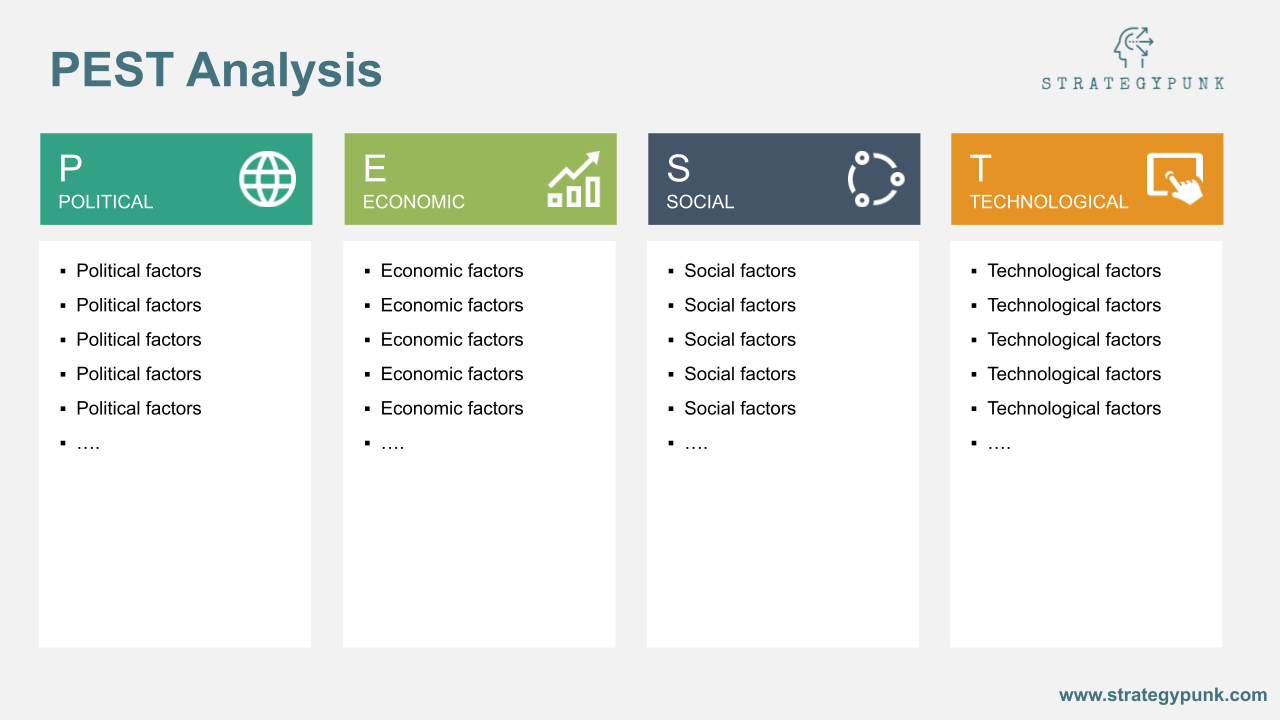
Strategic Insights 2024: A SWOT Analysis of Puma
Get your free PPT template for a detailed Puma SWOT analysis with Strategic Insights 2024. Unlock insights and strategies now!
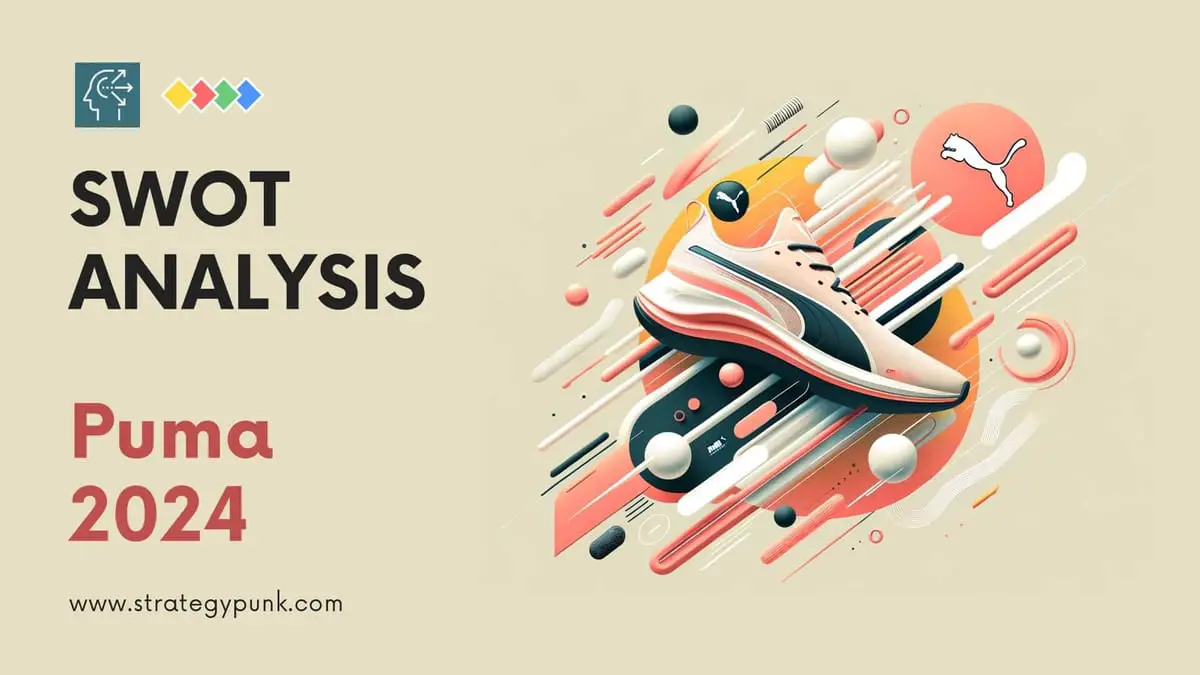
Strategic Insights 2024: A SWOT Analysis of adidas (Free PPT)
Explore 'Strategic Insights 2024: A SWOT Analysis of adidas' with our free PowerPoint template. Dive deep into adidas' strengths, weaknesses, opportunities, and threats in 2024.

Nike in 2024: Detailed SWOT Analysis with a Complimentary PowerPoint Template
Download Nike's 2024 SWOT Analysis: Comprehensive insights and free PowerPoint template. Key strategies, opportunities, and challenges revealed.




